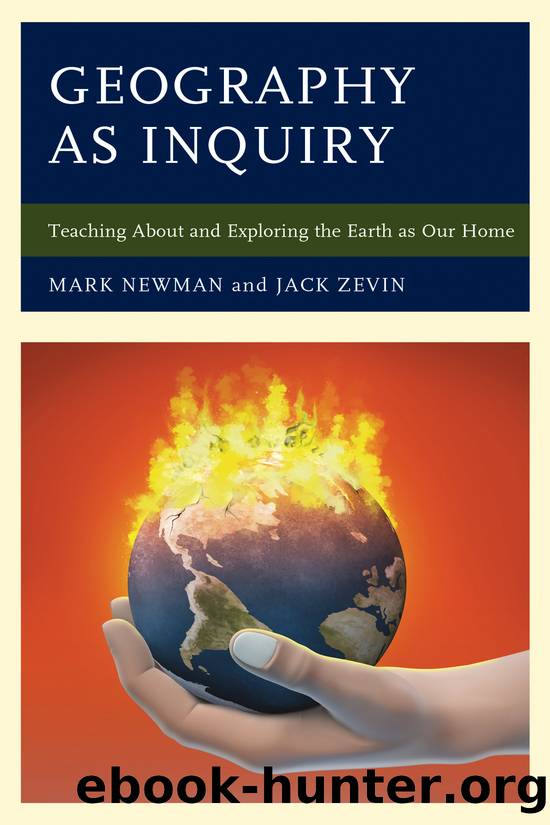Geography as Inquiry by Newman Mark;Zevin Jack;

Author:Newman, Mark;Zevin, Jack;
Language: eng
Format: epub
Publisher: Rowman & Littlefield Publishers
Figure 5.1 Family meal1
The picture above of a family enjoying a meal together is a good case in point. What we eat comes from the natural environment. It is cooked using energy taken from the earth or possibly captured from the sun. And we often eat our meals in the comfort of our homes.
A primary function of our home is to offer protection from the weather, insects, and possibly other animals that weâd prefer not to invite inside, such as squirrels or wild birds. Our homes do separate us from the world outside, but that separation is a pattern of interaction. It does not make us distinct from the environment. Our clothing also comes from plants and/or materials synthesized in some way from natural elements. Though serving other cultural needs, clothing, above all, protects us from nature.
If we were to trace back the origins, manufacture, and distribution of the food, water, clothing, and shelter related to the meal shown above, we would touch upon virtually every interaction people have with the environment: positive, negative, and anything in-between. The wood used to frame houses causes deforestation as does the construction of our furniture and other products made of wood, including the traditional pencil. The chemicals used to help produce our food possibly polluted the land and water. Growing crops might also have helped deplete water resources. Almost all of the energy that provides heat, cooling, and light is mined from the earth, depleting a finite resource and often leaving a toxic waste dump in its wake. On the plus side, to help us save energy and resources, many homes have solar panels and many communities demand recycling.
Not all of our interactions fit into the examples noted above. For instance, plants, especially food sources, and animals have been introduced to new areas where they have adapted well. The largest introduction of new plants and animals took place during the Columbian Exchange that occurred after Christopher Columbus discovered a way to cross the Atlantic Ocean. At times, adaptations caused ecological changes as new species replaced others. Think of the oranges that originated in China but are now connected to Florida, coffee from Africa now grown all over the world, potatoes from the Andes now associated with Ireland and Idaho.
This chapter explores some of the wide variety of ways that people interact with the environment, stressing the interplay of weather, water, land, and human actions related to food production and seeking a better livelihood. Three types of interaction are examined:
1. Adapting to the environment.
2. Adapting the natural environment to meet human needs (and often desires).
3. A mix of the two types above.
In myriad ways that often go unnoticed because they are so routine, our everyday life is filled with instances of our adapting to the environment. Do you wear sunglasses or apply sunscreen before stepping out in the sun? Do you walk under an umbrella when it rains? These are just a few examples of how we adapt to the environment. Think of your daily activities.
Download
This site does not store any files on its server. We only index and link to content provided by other sites. Please contact the content providers to delete copyright contents if any and email us, we'll remove relevant links or contents immediately.
The Art of Coaching Workbook by Elena Aguilar(50963)
Trainspotting by Irvine Welsh(21517)
Twilight of the Idols With the Antichrist and Ecce Homo by Friedrich Nietzsche(18501)
Fangirl by Rainbow Rowell(9094)
Periodization Training for Sports by Tudor Bompa(8168)
Change Your Questions, Change Your Life by Marilee Adams(7633)
This Is How You Lose Her by Junot Diaz(6778)
Asking the Right Questions: A Guide to Critical Thinking by M. Neil Browne & Stuart M. Keeley(5630)
Grit by Angela Duckworth(5512)
Red Sparrow by Jason Matthews(5390)
Paper Towns by Green John(5086)
Room 212 by Kate Stewart(5035)
Ken Follett - World without end by Ken Follett(4643)
Housekeeping by Marilynne Robinson(4329)
The Sports Rules Book by Human Kinetics(4288)
Double Down (Diary of a Wimpy Kid Book 11) by Jeff Kinney(4204)
Papillon (English) by Henri Charrière(4195)
The Motorcycle Diaries by Ernesto Che Guevara(4009)
Exercise Technique Manual for Resistance Training by National Strength & Conditioning Association(3955)
